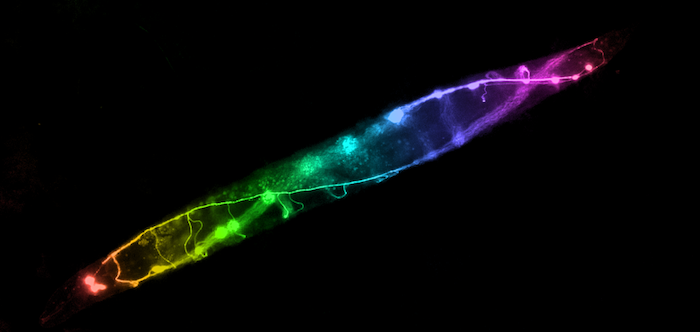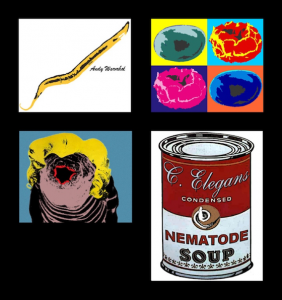
Worm pop art by James T. Wong. 2007.
In 1997, Ahna Skop approached her graduate advisor, John G. White, about adding a worm-themed art show to the International C. elegans Conference he was organizing that year. “He said I could do whatever I wanted, but not to involve him,” she recalls. That year marked the very first Worm Art Show, which has since become a beloved part of the annual meeting. This year, the worm community will celebrate the show’s 20th anniversary at the 21st International C. elegans Conference at UCLA June 21-25th.
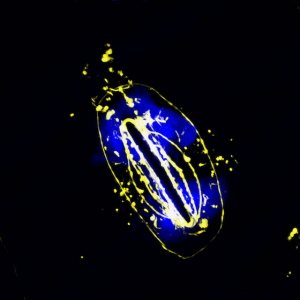
“Vulva monologues” by David Welchman. 2003.
For Skop, who was raised in a household of artists, uniting art and science came naturally. She first started studying C. elegans as an undergraduate, and remembers being struck by the beauty of microscope images in textbooks, even though she didn’t yet understand the science. The rest of the C. elegans research community responded enthusiastically to her inspired idea. The first show was small, but popular. Skop recalls that first show included a blown glass vase with the C. elegans genome sandblasted on the side and a driftwood mobile depicting the larval developmental stages. Even John White submitted a piece, a wooden reconstruction of the C. elegans vulva.

“Brisk swimmers” by Katherine Walstrom. 2011.
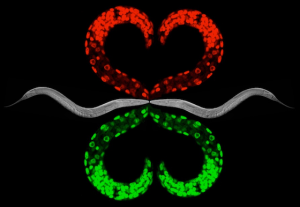
C. elegans art by Ahna Skop and Tri Nguyen. 1997.
These first submissions were pre-existing artistic works, and their creators were excited to finally have a place to share them. “People forget that science is a creative vocation,” Skop says. “Scientists are very creative in how they design their experiments, and it also comes out in their hobbies.” The data itself can also be quite beautiful; brilliantly colorful microscope images have been a staple of the art show since the beginning. Skop notes that microscopy is inherently a visually stimulating endeavor, a perfect example of the connection between science and art.
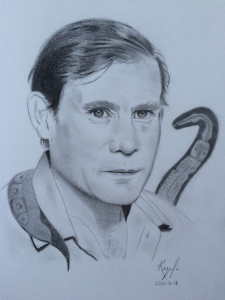
“On the shoulders of Lord Brenner” by Regina Lai. 2015.
The Worm Art Show has grown in size and popularity over the years, but the entries continue to be as varied as the researchers who attend the annual conference. C. elegans has now been interpreted in every media from embroidery to stained glass. According to Skop, the biggest change over the past 20 years has been the growing number of multimedia entries. Cell phone cameras and
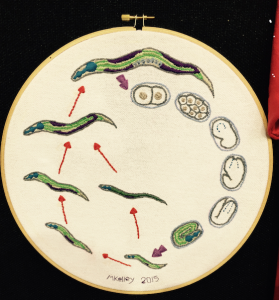
“Life cycle on a thread”, a second place winner by Melissa Kelley. 2015.
YouTube have made audio-visual creation more accessible and popular than ever. The Art Show has also acquired yearly themes–the celebration of Nobel Prize winners, for example, or this year’s “C. elegans for social justice.” But through it all, the Art Show has remained a fun celebration of the worm community. Prize winners are selected by popular vote, and the video entries are screened on the last night of the conference, with the winner decided by who gets the most applause.
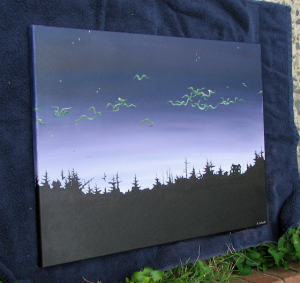
A painting by Adam Werts featuring C. elegans. 2007.
Skop, now an Associate Professor at the University of Wisconsin-Madison, has organized every Worm Art Show for the past 20 years. Though the full show is enjoyed only by conference attendees, she says the created works are a powerful way to reach out to non-scientists. “It’s a testament to what science is all about, and I want the public to actually know that,” she says. “This is an easy way to share the beauty of science and shows that scientists are creative people–not just old white men in lab coats.” As a faculty affiliate in the Arts Institute at UW-Madison, Skop can now train art
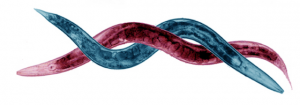
“C. elegans and C. briggsae” by Todd Harris. 2008.
students in her lab and has helped install large scientific art pieces in the UW-Madison genetics building celebrating fruit flies, mice, yeast, E. coli, and zebrafish, along with C. elegans. She would love to open a scientific art gallery someday where the innate beauty of science can speak to everyone.


